Dove’s Reuse/Refill Packaging Replaces Single-Use Bottles
Unilever’s new reusable packaging for Dove Body Wash encourages in-store and ecommerce shoppers to purchase smaller, more sustainable refill packs instead of single-use plastic bottles.

Sustainability is the watchword for a new product line from Unilever called Dove Body Wash Reusable Bottles + Concentrate Refills. The packaging design targets plastic waste with a buy once/refill many times concept.
The product’s starter kit comprises a reusable pump bottle made of either aluminum or high-density polyethylene (HDPE), plus one 4-oz HDPE refill bottle containing body wash concentrate. The HDPE in both cases is recyclable. After their initial purchase, consumers only buy the small refills.
To whip up a batch of body wash, consumers simply screw the refill’s mess-free “quick-connect cap” onto the larger bottle. Continued twisting produces a loud “click,” the cue to squeeze the contents of the refill into the reusable bottle.
Next, users add water to the larger bottle, replace and relock the pump, and shake to mix the water and concentrate. The pump locks and unlocks with a simple twist, but without a change in elevation, the way some other pumps work. According to Unilever, the pump height is not an aid for proper product dosing.
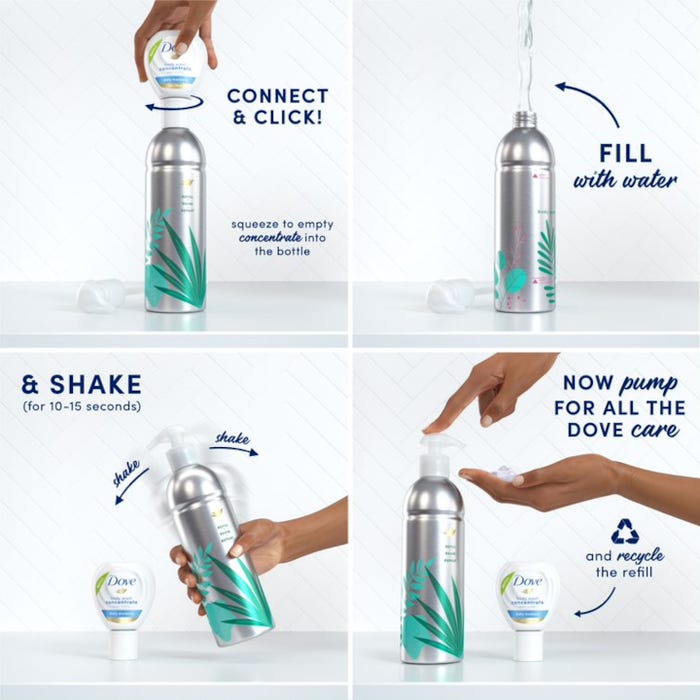
Each reusable bottle holds 16 ounces of reconstituted body wash, and a translucent vertical strip on the HDPE reusable container reveals how much of the mixture is in the bottle. The refill bottles feature a similar see-through strip.
The back of the starter kit is printed with simple directions explaining how to refill the bottle. Additionally, a quick response (QR) code on the starter kit and on the refill’s labels takes consumers to a video showing how to use the packaging.
Unilever’s calculations indicate that, after consumers use up two refills in the aluminum bottle and four in the plastic bottle, they’ve used 50% less plastic than if they had used the same volume of Dove body wash in standard single-use packaging.
In addition, Dove Body Wash Reusable Bottles + Concentrate Refills contain 80% less water when shipped (per refill) and produce 21% fewer greenhouse gas (GHG) emissions from manufacturing over the course of a year, Unilever estimates.
The company sells the starter kit and refills in brick-and-mortar stores and via Amazon and other online vendors. Dove Body Wash Concentrate Refills come in three formulas: Shea & Warm Vanilla, Daily Moisture, and Cucumber.
Secondary packaging and graphics.
The packaging concept is well suited to ecommerce. In addition to being small and relatively lightweight, the refill bottles feature a permanently attached closure that prevents leaks. And for the starter kits sold on Amazon, Unilever developed a corrugated shipper decorated with Dove’s brand graphics.
Secondary packaging for the brick-and-mortar retail starter kit is a micro-flute corrugated display pack with die cuts, flaps, and a corrugated insert to hold the reusable bottle and refill in place; a dot of adhesive provides extra security for keeping the refill in place.
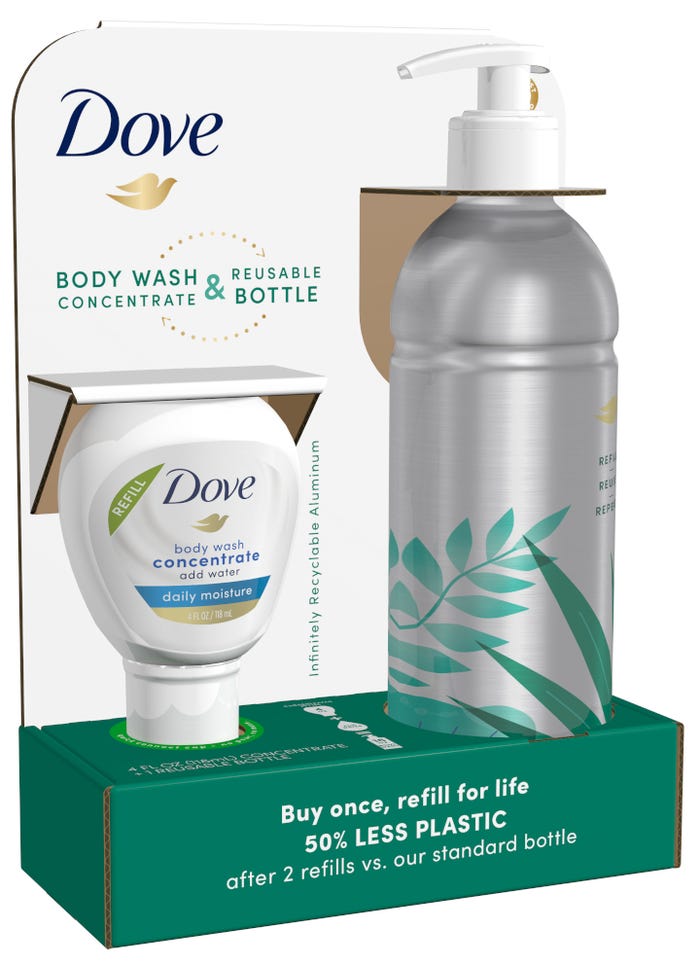
One clever feature of the secondary packaging is that the flap around the neck of the reusable bottle, which holds it in place, requires consumers to unscrew and remove the pump before removing the bottle from the display pack. This design leads consumers to take the first step in filling the reusable bottle: Remove the pump closure.
Packaging Digest asked Unilever how the corrugated display pack was set up and loaded, and whether that was performed in-house or by a contract packager. Unilever replied that “manufacturing information is proprietary.” The company also declined to identify packaging suppliers involved in this project.
Unilever did confirm that the reusable containers are decorated using direct-print techniques but did not specify the printing technologies. Arrows printed on the reusable HDPE and aluminum bottles show consumers the correct fill levels for Step 1 (adding concentrate) and Step 2 (adding water).
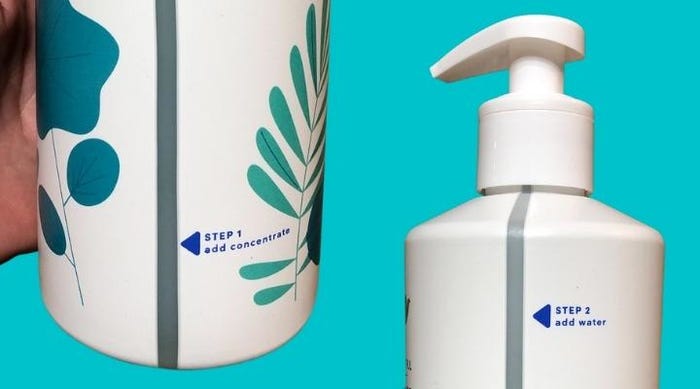
These bottles don’t look like what you see on a store shelf, with a prominent brand name and logo, product identification and attributes, ingredients, manufacturer details, bar codes, and other label content. Designed to meet the Dove aesthetic, the reusable bottles feature simple graphics and branding so they can be used and displayed for a long time. And the graphics are generic enough to complement a range of bathroom decors.
When considering the cost/value trade-off, it’ll be interesting to see if consumers will pay about three times the price for body wash to achieve the environmental benefit of saving plastic waste, especially in light of the trend toward refillable dispensers in showers for households and hotels alike.
In this in-depth Q&A, Unilever’s Jody Wilson, senior manager, package development skin cleansing, and Mauricio Jimenez, senior brand manager, answer questions from Packaging Digest about the package concept, design, and benefits.
Was the structural design for this packaging developed in-house at Unilever?
Wilson: Yes, the quick-connect cap was originally designed in our Homecare division and is used on brands like CIF globally. We know refilling products like body wash can be messy when pouring from one pack to another. The quick-connect cap allows for a clean, mess-free refilling experience.
The innovative technology allows the cap to easily connect and seamlessly release the concentrated formulation without pouring. The refill bottles are designed to meet the Dove aesthetic, optimized to reduce plastic, are squeezable, and have a view strip to ensure complete evacuation of the product. They are made from 100% post-consumer recycled (PCR) plastic and are recyclable.
Why offer two reusable bottle types (aluminum and plastic)?
Wilson: Dove created both the 100% recycled plastic bottle and the aluminum bottle to help meet consumer preferences regarding price and material.
For those who would prefer to purchase the least amount of plastic, the aluminum bottle is available at a higher price point. Alternately, the recycled plastic bottle is available at a lower price point than the aluminum bottle.
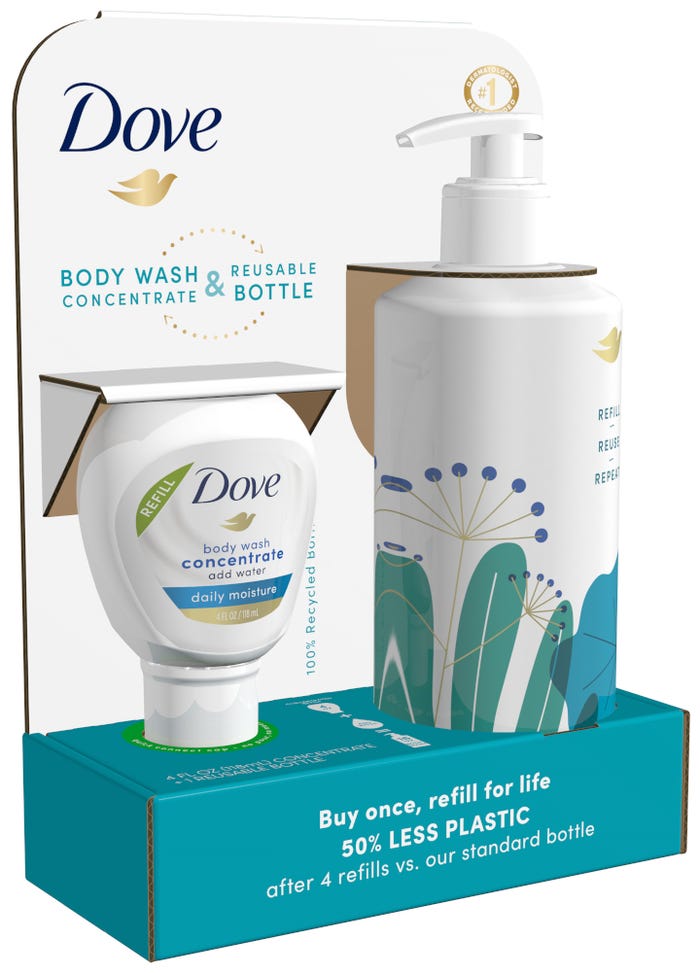
Is the reusable aluminum bottle treated or coated on the outside to prevent rust stains?
Wilson: The reusable aluminum bottles are rust-proof because aluminum does not rust.
The window strip on the reusable plastic bottle is helpful to see how much product is left and to view the fill level when adding water. It’s probably impossible to add a window strip on the aluminum reusable bottle — is that why there’s an indented ring around the aluminum bottle? As in aid in filling water to the correct level?
Wilson: Yes, the indented line on the aluminum reusable bottle is meant as an indicator for filling water to the correct level. There are graphics on the side of the aluminum bottle that indicate where to fill water to.
The threads on the reusable bottles and on the pumps look standard for the industry. Are they?
Wilson: Yes, they’re standard.
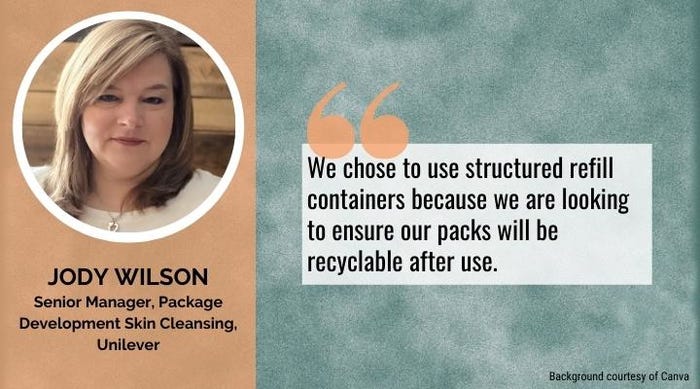
Why use rigid containers for the refill packaging, instead of flexible packaging, for example, or tablets in a flow wrap?
Wilson: We chose to use structured refill containers because we are looking to ensure our packs will be recyclable after use.
Why stand the small refill bottles on their heads, with graphics upside down?
Wilson: When the Concentrate Refill is connected to the reusable bottle it is oriented in the proper direction. Additionally, when displayed on shelves in store, the bottles are displayed in the proper orientation to ensure that the graphics are facing the consumer.
Why put a viewing strip on the small refill bottle if it is supposed to be fully dispensed all at once into the reusable bottle?
Wilson: To give consumers extra reassurance that all product has been dispensed from the refill. Based on consumer feedback in trials, we wanted to give consumers extra reassurance that all product had been dispensed.
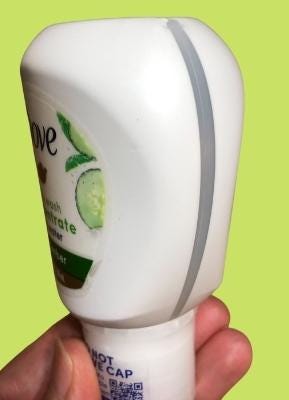
Is the closure on the refill bottle polypropylene? If so, how is it able to be recycled with the HDPE container since it isn’t removed first?
Wilson: Yes, it is polypropylene and does not need to be removed per How2Recycle guidelines.
On the small refill bottle, the closure is non-removable (or difficult-to-remove). Is the thread design standard?
Wilson: It’s custom designed.
Do simple ratchets keep the closure from being unscrewed easily from the refill bottle?
Wilson: Correct, the closure has been custom designed to work with the quick-connect cap.
Who engineered the closure on the refill bottle? What were some of the challenges?
Wilson: The closure on the refill bottle and quick-connect cap is custom designed. We leveraged the closure design from our Homecare division where it is used on brands like CIF globally.
It appears that the act of screwing the refill bottle onto the reusable bottle pushes down an internal plunger that breaks a frangible seal, creating a sound to let you know the refill bottle has been properly connected to the reusable bottle. This separated seal — a circular piece of plastic, molded into the closure design — drops into the refill bottle so the concentrated body wash can be dispensed into the reusable bottle with easy squeezing. Is this how the refill bottle’s closure works?
Wilson: Yes, the quick-connect cap makes a “click” sound once it’s connected to the reusable bottle. Once connected, the Concentrate Refill is dispensed into the bottle by squeezing the packaging.
With this reusable/refillable packaging system, you are reducing “plastic waste” — which is a little different from other brands that talk about reducing “plastic” — by switching to other packaging materials. Why is this significant? How successful do you think your message will be?
Jimenez: Dove currently has more than 100 different projects running across the world looking at every facet of our packaging, across the three dimensions of no/better/less plastic. We know that reusables are of huge interest to consumers, and as industry leaders, it’s our responsibility to drive innovations that incentivize purchase behaviors with products that enable people to consume more consciously.
Following the introduction of 100% recyclable PCR plastic body wash bottles in 2019 and Dove 0% Aluminum Refillable Deodorant in 2021, the introduction of Dove Reusable Body Wash Bottles + Concentrate Refills is the latest move to fulfill the brand’s commitment to transition all Dove packaging to be plastic-free, made from 100% PCR plastics, or reusable/refillable by 2025.
Although this innovative packaging system is currently only available in the body wash format, we are exploring reusable bottles for other products for future release.
How did you determine that this packaging system produces 21% fewer GHG emissions from manufacturing over a year?
Jimenez: Dove hired a team of independent consultants to calculate the environmental footprint of our concentrated body wash and refillable bottle, compared to our standard 22-oz body wash. The experts considered impacts from sourcing to manufacturing and disposal.
How is your reusable/refillable packaging system different from those sold in partnership with Loop?
Jimenez: Loop is a great partner, but the Dove Body Wash Reusable Bottles + Concentrate Refills are not part of their program. [Editor’s note: The Dove containers do not need to be commercially cleaned between uses like the packages in the Loop program are.]
Why use the How2Recycle label on the refill bottles?
Wilson: Unilever North America is striving to include How2Recycle labels on all products.
On the back label of the refill bottle, there is an icon that says, “100% recycled bottle.” The white refill bottle does not look like it contains any recycled-content material. Do you mean recyclable?
Wilson: Dove Body Wash Concentrate Refill packaging is recyclable and made from 100% recycled HDPE.
With all these packaging components — corrugated display, reusable bottle, pump, refill bottle, three pressure-sensitive labels (including a multilayer label on the back of the refill) — the cost of the packaging seems high, especially considering the relatively low price point of the product. Why invest so much in the packaging for this product?
Jimenez: We are committed to making a change in the marketplace and creating a simple, intuitive, mess-free reusable body wash bottle, which requires an investment.
Dove Reusable Body Wash Bottles + Concentrate Refills are a system, and the reusable bottle is an important investment to transition away from single-use plastics. By offering reusable products, we are promoting a behavior change and transitioning consumers away from repurchasing single-use plastic bottles to purchasing only Concentrate Refills.
The instructions for use are simple yet effective. How easy or hard was it to create these?
Wilson: We connected with consumers to test, refine, and revalidate our instructions to ensure that product use is a seamless process. We conducted two rounds of testing, developed with input from trials, due to the consumer behavior change of transitioning to reusables and concentrates.
Cue sounds like the “click” when the quick-connect cap is connected to the refill bottle, or cue messaging to instruct consumers not to remove the concentrate cap, are important to indicate proper product usage.
You have a QR code on the front label of the refill closure and on the inside of the back multipanel label that takes consumers to a video of instructions for how to use the packaging. Why put this in two locations on the same package? (The QR code also appears a third time on the corrugated display pack.)
Wilson: There is a QR code on both the front label and inside the multipanel label because when you buy the starter kit, you have it to reference, but ultimately when consumers are only purchasing refills, they will need to maintain a point of reference.
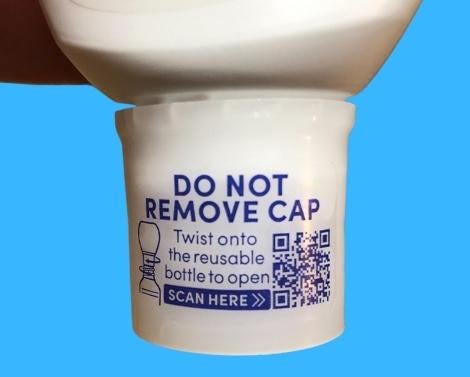
Why create a special pack for Amazon/ecommerce? What type of ecommerce sales are you anticipating?
Jimenez: We created a Dove Reusable Body Wash Bottles + Concentrate Refill Starter Kit exclusively for Amazon, to create the most value for our Amazon consumer base.
Is the Amazon Starter Pack considered Amazon SIOC (“ships in own container”) packaging?
Jimenez: Dove Reusable Body Wash Bottles + Concentrate Refill Amazon Kits are designed for SIOC packaging.
Is the Amazon shipper made of corrugated board?
Wilson: Yes, the Amazon Starter Kit is an e-flute corrugated board.
Does Unilever use the same corrugated display packs (sold at Target and other brick-and-mortar retailers) for the starter kits sold via Amazon?
Wilson: The pack out is different for Amazon than for Target and other brick-and-mortar retailers. For Amazon, the Dove Body Wash Reusable Bottle is sold with two Concentrate Refills. They are packaged in a SIOC box with an insert designed for the ecommerce channel to securely protect and hold the contents during shipping.
Because of the sealed design of the closure on the refill pack, this packaging system probably doesn’t require any additional leak-prevention packaging (typically a zipper bag) when shipping from Amazon. Correct?
Jimenez: Dove Reusable Body Wash Bottles + Concentrate Refills do not require any additional packaging and have met Amazon’s ISTA-6A certification requirement.
Are there plans to use a similar packaging concept for other liquid products from Unilever?
Jimenez: Although this innovative packaging system is currently only available in the body wash format, we are exploring reusable bottles for other products for future release.
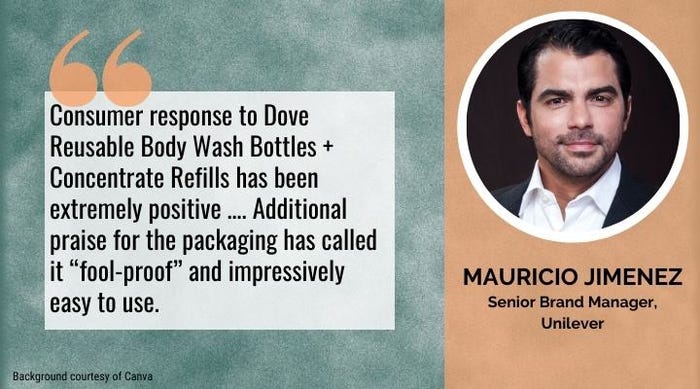
How have consumers reacted to this product and packaging?
Jimenez: Consumer response to Dove Reusable Body Wash Bottles + Concentrate Refills has been extremely positive, noting that the product leaves skin feeling super soft and smooth, just like the standard Dove Body Wash. Additional praise for the packaging has called it “fool-proof” and impressively easy to use.
About the Author(s)
You May Also Like






